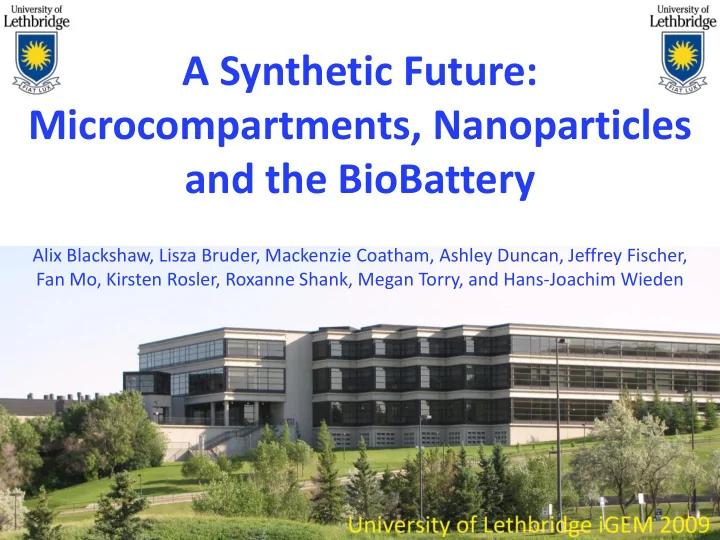

A Synthetic Future: Microcompartments, Nanoparticles and the BioBattery Alix Blackshaw, Lisza Bruder, Mackenzie Coatham, Ashley Duncan, Jeffrey Fischer, Fan Mo, Kirsten Rosler, Roxanne Shank, Megan Torry, and Hans-Joachim Wieden
Overview Our Project : Develop compartments in Bacteria Two Approaches to Compartmentalization: nanoparticles and microcompartments Technological Applications Human Practices : Science in Southern Alberta
Compartmentalization Eukaryotes segregate metabolic processes into compartments Chloroplast Vacuole Mitochondria Golgi Apparatus Nucleus Prokaryotes lack distinct organelles TEM image of a plant parenchyma cell. From “The Cell: A Molecular Approach “4 th edition (Cooper and Hausman 2006)
Compartmentalization: A Foundational Advance Concentrate Isolate Toxic Substances Components Bring Components Reduce into close Cross-Talk proximity Co-localizing cellular processes in bacteria will improve the efficiency of the system
Isolating Toxic Components through Compartmentalization pLacI RBS Mms6 dT Mms6 from Magnetospirillum magneticum IPTG inducible construct was produced in collaboration with the UNIVERSITY OF ALBERTA EM image of nanoparticles formed in the presence of Mms6. From Prozorov et al., 2007
A Self-Assembling Cage Monomer Homopentamer Lumazine Synthase Capsid Lumazine synthase from Aquifex aeolicus forms 60 subunit icosahedral capsids
Targeting Strategy Glutamate mutations produce a highly negative interior of the lumazine synthase microcompartment Wild-type (-15 formal charge) 4X Glu mutant (-40 formal charge) A positively charged protein may be targeted to the inside of the microcompartment
BioFusion Vectors 10 Arginine residues (R 10 ) were attached to either the N- or C-terminus of YFP YFP Restriction Ligation Express Digestion C- or N- terminal C- or N- terminal C- or N- terminal R 10 Fusion Vector R 10 Fusion Vector R 10 YFP
Fluorescence of YFP Constructs 20 λ excitation = 514 nm Fold Change in Fluorescence 15 10 5 0 λ emission = 526-527 nm
Modelling the Capsid Volume of interior – 299 - 369 nm 3 (Fluorescent proteins are 56 nm 3 ) Pore size – 1.93 nm 1.93 nm diameter 8.3-8.9 nm diameter
Studying Co-localization through FRET λ excitation = 439 nm λ emission = 476 nm λ emission = 527 nm Distance dependent mechanism Diameter of microcompartment is 8.9 nm
Characterizing Co-localization – the Mechanism concentration LS Protein FP Increasing Concentration of Ara and IPTG
Characterizing Co-localization – the Mechanism No Ara, IPTG induced FP concentration LS Protein Time
Characterizing Co-localization – the Mechanism Induced with IPTG and Ara concentration LS Protein FP Time
Future Applications Electron Flow Sunlight • Co-localization of metabolic proteins or processes O 2 + 2H + CO 2 + H 2 0 + light • Sequestering toxic Mediator gene products e - H 2 0 (CH 2 O) n + 0 2 + H 2 0 • Delivery capsid Anode Cathode Cyanobacteria H +
Science in Southern Alberta Opinion of Genetic Engineering Opinion of Synthetic Biology
Science in Southern Alberta Interest in Interest in Scientific Science Career
Accomplishments • 31 new BioBrick parts • Improved on U of L 2008 iGEM team’s riboswitch construct • Collaborated with the University of Alberta, Valencia and TUDelft • Created and characterized fusion cloning vectors for targeting proteins into Lumazine synthase microcompartments, where the proteins remained functional
Acknowledgements University Dave of Franz Lethbridge Students’ Union John Thibault The Wieden Lab Sebastian Nathan Machula The Kothe Lab Puhl
Recommend
More recommend